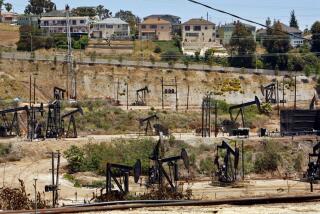More Offshore Drilling Because of Saddam? : Why the scare argument won’t scare California
California’s splendid coastline, now great stretches of sunlit sand, now craggy headlands brooding in fog, is an irreplaceable resource. Oil spills in Alaska, the Northeast and Houston make it seem even more precious and vulnerable.
Partly on aesthetic grounds, partly because estimates of the quantity of oil that remains to be discovered seem so low, the clamor for expanding oil operations up and down California’s coast has always been dubious. Using the Persian Gulf crisis to make drilling seem a matter of economic life-and-death takes the clamor beyond dubious to downright spurious.
Mere weeks ago President Bush accepted the National Academy of Science’s finding that nobody understands the environmental effects of offshore drilling well enough to plunge forward, at least in sensitive areas off California and Florida. In June, he ordered further sales of leases beyond the 3-mile limit postponed indefinitely. Science certainly has not accumulated enough new information since then to say that it’s all right to drill now.
The oil industry push for immediate action also ignores the calendar. It takes time--often as much as 10 years--to start producing offshore oil, even if exploration rigs find enough crude to make production worthwhile.
Conservation could cut America’s dependence on oil--not just from wells off the California coast but from anywhere in the world--in far less time than that. The U.S. Energy Department noted just this week, for example, that Americans could save 100,000 barrels of oil a day simply by not letting their automobile tires go soft! And driving at the speed limit would save another 50,000 barrels.
A comparison is in order. The Energy Department’s suggestions would save twice as much oil as Chevron’s new platforms off Pt. Arguello, near Santa Barbara, will produce when and if the argument over the environmentally safest way to bring the oil to shore is settled.
In a nation whose appetite for oil is counted in the millions of barrels a day, not the thousands, such savings seem modest. But the same can be said of estimates of the amount of oil that might be found off California, even with unrestricted exploration.
The U.S. Interior Department’s Minerals Management Service estimates that the amount of oil waiting to be discovered beyond the 3-mile-limit off California’s coast is nearly 600 million barrels.
At current rates of oil consumption in the United States, that amount of oil would keep American cars, power plants, diesel engines and other oil guzzlers going for a few days over one month. It would keep them going, that is, if it could all be pumped at once. But it has already taken most of this century to pump less than that from existing offshore fields.
All told, there probably are slightly less than 2 billion barrels of oil left under the ocean floor off California. According to the Sierra Club, the nation would be saving twice that much oil every single day at the end of 10 years if Congress raises automobile fuel efficiency standards from the current 27.5 m.p.g. to 40 m.p.g.
The lesson here, of course, goes far beyond the California coast. It is a lesson about America’s appetite for oil and the relatively simple steps the nation could take to control it. Another energy-saver on the Sierra Club’s list, for instance, is to saturate the nation with more efficient electrical appliances--even ones that are required to cost less over their lifetime than energy-guzzlers. Using them could cut American energy consumption by the equivalent of 10.4 billion barrels over a 20-year span.
The oil industry has a right to argue that the gulf crisis means America needs more oil. But somehow the case that it also demonstrates a need to get by on less seems more compelling.
More to Read
Sign up for Essential California
The most important California stories and recommendations in your inbox every morning.
You may occasionally receive promotional content from the Los Angeles Times.









